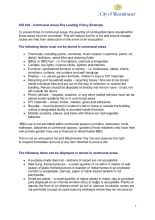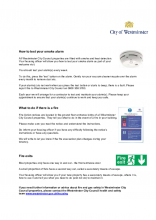Staying safe in your home
Fire safety
We are responsible for fire safety in the communal areas of our properties and ensure fire safety in your home by:
- completing fire risk assessments in each block to identify fire risks
- completing regular health and safety and security block inspections to identify defects and housekeeping issues
- installing, testing and maintaining fire detection systems in tenanted properties
- ensuring fire doors, emergency lighting and other fire safety features installed in our buildings are regularly tested and maintained
- ensuring communal areas of buildings are kept clear of combustible items such as personal items and waste
- working with the London Fire Brigade and endorsing their free home safety visits to all residents
When you sign your tenancy agreement we will give you information about fire safety, including:
- a fire strategy for your block. A copy is included in your welcome pack. If you have misplaced it you can request a new copy by emailing housingfiresafety@westminster.gov.uk
- the fire safety features of your property, including the location of your fire detectors and how to test them
- any secondary escape routes from your flat
- our communal fire loading policy on communal storage and what items you are permitted to place in the communal parts
Fire doors
The proper use of fire doors is crucial to ensuring safety in your home. As part of our Fire Risk Assessments we check that all our properties have working fire doors, but there are a few things you can do to ensure fire doors in your home and building are effective:
- never prop open a fire door, they should remain closed at all times
- if you see a fire door that looks in disrepair, report it to us immediately on 0800 358 3783
Leaseholders are responsible for maintaining their fire doors and should follow our leaseholder fire safety guidance to do this.
Your responsibilities
It is important that everyone is aware of what to do in the event of a fire. Please ensure that everyone in your household knows what action to take in the event of a fire in your home. Information on what to do in the event of a fire is clearly displayed in the communal areas of your building.
Other things you can do to protect yourself against fire:
- test your smoke alarm weekly
- do not store personal items in communal areas, read our policy on communal fire loading for more information
- allow our staff and contractors access to your property to test your fire alarms and inspect any secondary means-of-escape routes. We will ensure they have proof of identity when they visit
Things to avoid
Please make sure you do not:
- obstruct any secondary means of escape route
- install additional locks or chains to either your front door or secondary means-of-escape door as they could prevent you escaping a fire
- make any alterations to your home without our written permission. You could affect the fire safety precautions within your home
- tamper with or vandalise any fire precautions, such as fire doors in communal areas
Get a free home fire safety visit
The London Fire Brigade can visit you at home to offer advice on how to make your home safe. If you are a leaseholder they will fit you a smoke alarm for free.
To request a visit:
Visit the London Fire Brigade website.
Call: 08000 28 44 28
Email: smokealarms@london-fire.gov.uk
Asbestos
In the 1960s and 1970s asbestos was widely used in building materials and products due to its durability and heat resistant qualities. Low levels of asbestos are commonly found in residential properties in:
- floor tiles
- pipe insulation
- textured coatings
- some toilet cisterns
Although asbestos is a hazardous material it can only pose a risk to your health if the fibres are disturbed and become airborne.
This could occur if the material containing asbestos is drilled, sanded, cut or broken up; or if the material is in a poor condition or damaged.
Exposure
Exposure to low levels of fibres is unlikely to harm your health. It is very unlikely that the levels of asbestos fibres found within your home will be harmful but if you have damaged asbestos materials in your home you should contact us immediately.
High, short-term exposure to asbestos fibres can occur during DIY projects so please be careful when making any changes to your home.
Any repairs or major works undertaken in your home by our appointed contractors will include a risk assessment during which checks will be made to see if they are likely to disturb asbestos.
Where asbestos is found to be damaged or may be disturbed it will be dealt with or removed by our contractors.
You can find more information on asbestos on the Health and Safety Executive website.
Related documents







